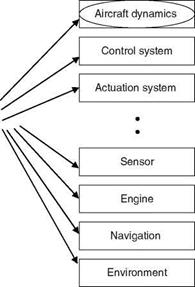Equations of Motion
3.1 INTRODUCTION
In Chapter 2, a system was defined as a set of components or activities that interact to achieve a desired task. The primary requirement to study a system, be it a chemical plant or a flight vehicle, is a model that closely resembles the system. In other words, a model is a simplified representation of a system that helps to understand, predict, and possibly control its behavior. It presents a workable knowledge of the system and simulates its behavior. Some authors also refer to a model as a less complex form of reality.
A flight vehicle is a complex system that requires a number of models for its various components (Figure 3.1). In this chapter, we describe the model form that represents aircraft dynamics. When an aircraft flies, it experiences gravitational, propulsive, and inertial forces arising from the airflow over the aircraft frame. To achieve a steady, unaccelerated flight, these forces must balance out one another. The upward force, due to the lift, should be in equilibrium with the downward force, due to the weight of the aircraft, so that it does not experience unsteadiness (unintentional one). Similarly, the forward thrust force should be in equilibrium with the opposing drag force so that the aircraft does not accelerate and, hence, is steady. An aircraft satisfying these requirements is said to be in a state of equilibrium or flying at trim condition. Normally at trim, the translational and angular accelerations are zero. The notations and terms used in describing aircraft dynamics are given in Appendix A.
Both the equations of motion (EOM) and the models of the aerodynamic force and moment coefficients have to be postulated to describe the aircraft motion in flight (Figure 3.2). Aircraft EOM comprise aircraft motion variables (aircraft states) such as airspeed, flow angles (angle of attack and sideslip angles), angular velocities (pitch, rate, and yaw), and attitude angles (bank, pitch, and heading), formulated as differential equations. The collection of these aircraft motion variables is called the state vector, which helps describe the motion of the flight vehicle at any given point of time. Aircraft EOM are described in various textbooks and reports [1-6]. The core issue in flight mechanics is to evaluate aircraft performance and dynamics. The laws that govern the motion of an aircraft are those of Newton, provided the aircraft is a rigid body. It is well known that, at high velocities, aircraft dynamics are affected by structural elasticity. However, for understanding the dynamics of flight, it is convenient to consider aircraft as a rigid body with its mass concentrated at its center of gravity (CG). There are ways of adding on the aeroelastic effects to the rigid formulation. With this all-important assumption of the aircraft as a rigid body, we can elaborate on the forces and moments experienced by aircraft in flight, which we referred to in the definition of equilibrium of aircraft flight.
|

FIGURE 3.1 Aircraft model components.











